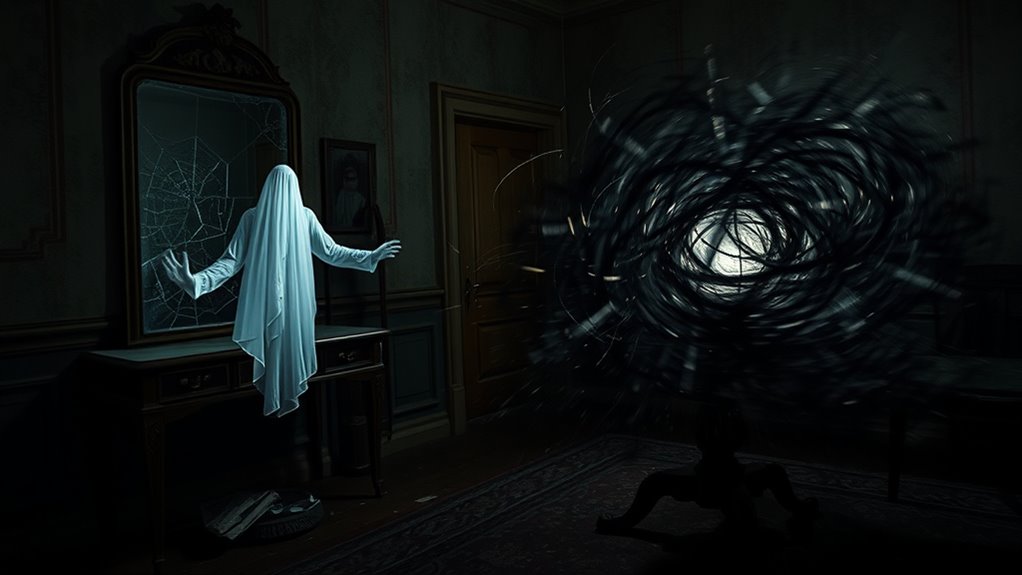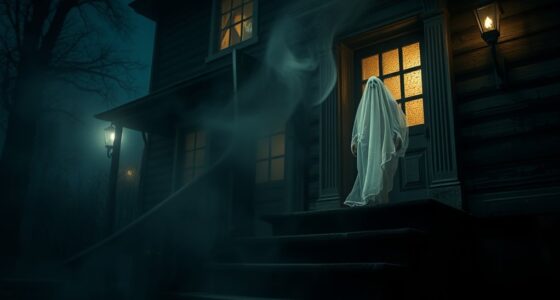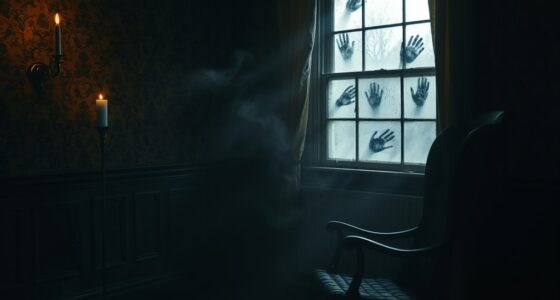A ghost is usually a residual spirit that repeats past actions, appearing as static figures or sounds linked to unfinished business. In contrast, a poltergeist is an active, intelligent force that manipulates objects, causes loud noises, and creates chaos. Ghosts tend to be less interactive, while poltergeists are unpredictable and disruptive. Want to understand more about these supernatural beings and how they differ? Keep exploring to uncover the full story.
Key Takeaways
- Ghosts typically leave residual energy causing static, unchanging phenomena, while poltergeists exhibit active, disruptive behavior.
- Ghosts often appear as apparitions or sounds stuck in time, whereas poltergeists manipulate objects and create loud disturbances.
- Residual hauntings are passive, with ghosts repeating past actions; poltergeists are intelligent and intentionally cause chaos.
- Ghost manifestations are usually less interactive and more about lingering presence; poltergeists respond to emotional or environmental triggers.
- Scientific explanations often attribute ghost sightings to psychological or environmental factors, while poltergeist activity is linked to energetic disturbances.
Origins and Historical Perspectives
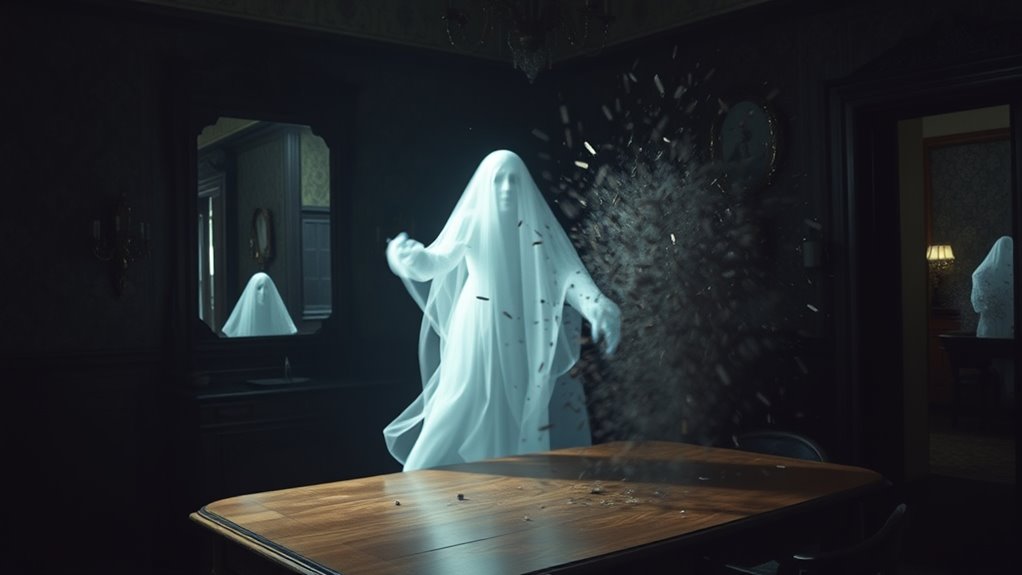
The origins of ghosts and poltergeists date back centuries and are deeply rooted in various cultural and religious beliefs. Spiritual origins often link these phenomena to the idea that spirits or souls of the deceased remain among the living, seeking resolution or closure. Historical accounts from different civilizations, such as ancient China, Greece, and Europe, document encounters with restless spirits and mysterious disturbances believed to be caused by supernatural forces. These stories reflect humanity’s long-standing attempt to understand death, the afterlife, and the unseen world. Over time, perceptions evolved, but the core belief remains that spirits can influence the physical sphere. These historical accounts provide the foundation for how societies have interpreted and explained ghostly and poltergeist activity through the ages. Additionally, the spiritual explanations for these phenomena continue to influence modern interpretations and beliefs surrounding unexplained disturbances. The cultural significance of these stories highlights their importance in shaping societal attitudes toward death and the afterlife. Moreover, some theories suggest that psychological factors may contribute to perceptions of paranormal activity, further complicating the understanding of such phenomena. For instance, psychological explanations often involve the human tendency to interpret ambiguous stimuli as supernatural, especially in stressful or grief-stricken contexts. As scientific research advances, many scientists seek natural explanations for these occurrences, though they often remain inconclusive.
Characteristics and Behavioral Traits

Ghosts and poltergeists often display distinct behaviors that help differentiate them. Ghosts typically show residual energy, repeating past actions without awareness, like lingering footsteps or sounds. In contrast, poltergeists are known for active, unpredictable activity driven by intelligent hauntings, often responding to the environment or people. They may also manipulate objects or create disturbances that suggest some form of conscious intent.
Manifestations and Signs
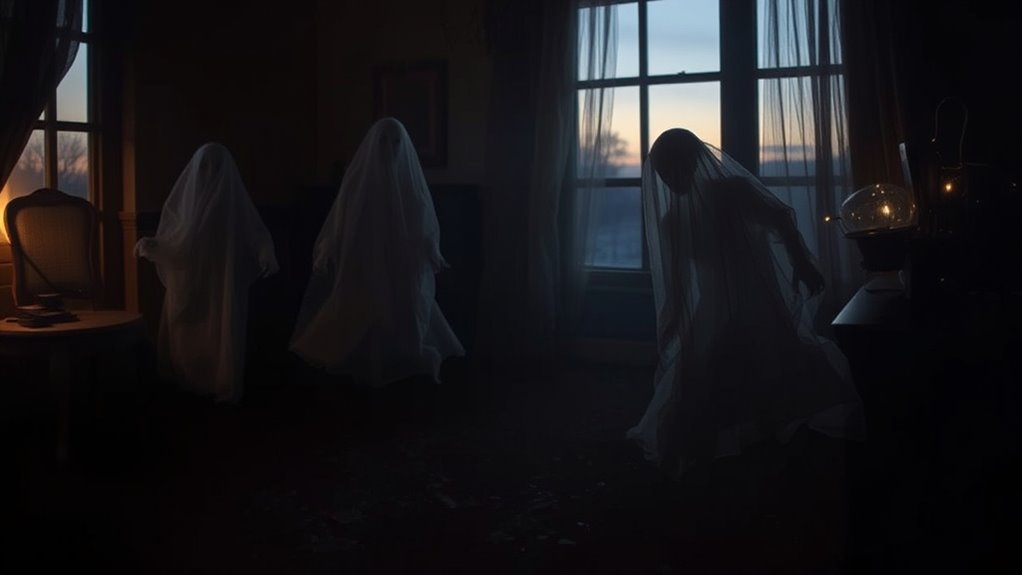
Manifestations and signs of ghostly activity can vary widely, often serving as clues to the presence of supernatural entities. You might notice sudden energy fluctuations, like cold spots or unexplained gusts of wind, which can indicate a spirit’s presence. Lights flickering or objects moving without explanation are common signs, especially when environmental influences seem insufficient to explain them. You may also hear disembodied voices or strange sounds that seem to respond to your presence. These signs often correlate with specific locations or times, hinting at underlying supernatural energy. While environmental influences can sometimes mimic these phenomena, persistent or unexplainable activity suggests a paranormal cause. Recognizing these manifestations helps you differentiate between natural occurrences and genuine ghostly signs. Understanding these signs can help you better identify genuine paranormal activity versus natural explanations. Being aware of manifestation patterns can further aid in distinguishing between natural and supernatural causes, especially when considering haunted locations and their histories. Additionally, studying common manifestation types can provide insight into the different ways spirits communicate or manifest. For example, some manifestations are fleeting and subtle, while others are more intense and dramatic, which can influence how you interpret their significance.
Theories and Explanations
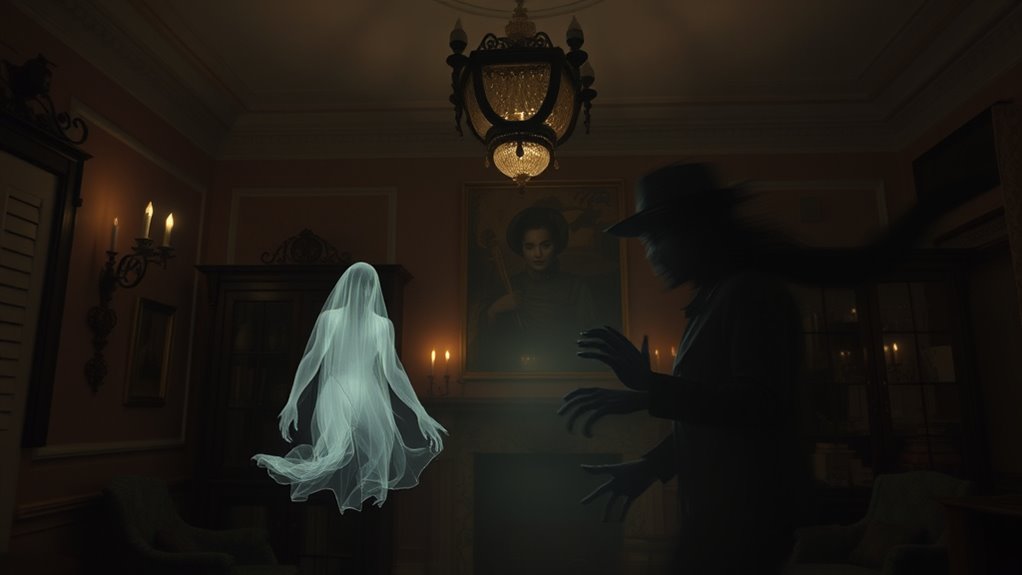
Many scientists and skeptics suggest that what people interpret as ghostly activity can often be explained by natural or psychological factors. For example, sleep paralysis, hallucinations, and environmental influences like drafts or electromagnetic fields can create sensations of a presence or unexplained noises. environmental influences such as electromagnetic fields are known to affect brain activity, leading to experiences of inexplicable phenomena. These influences can trigger perceptual distortions, causing individuals to perceive phenomena that are not actually present. Scientific explanations emphasize that our minds are prone to cognitive biases, which can lead to perceiving spirits where there are none. Additionally, cognitive biases can distort perception, making naturally occurring phenomena seem supernatural. The complexity of neurological processes involved in perception supports the idea that many ghostly encounters are rooted in the brain’s interpretation of ambiguous stimuli. Understanding these theories helps demystify experiences and encourages critical thinking about what’s truly behind ghostly encounters. Furthermore, psychological factors such as stress and expectation can significantly influence perceptions of paranormal activity.
Cultural and Folklore Variations
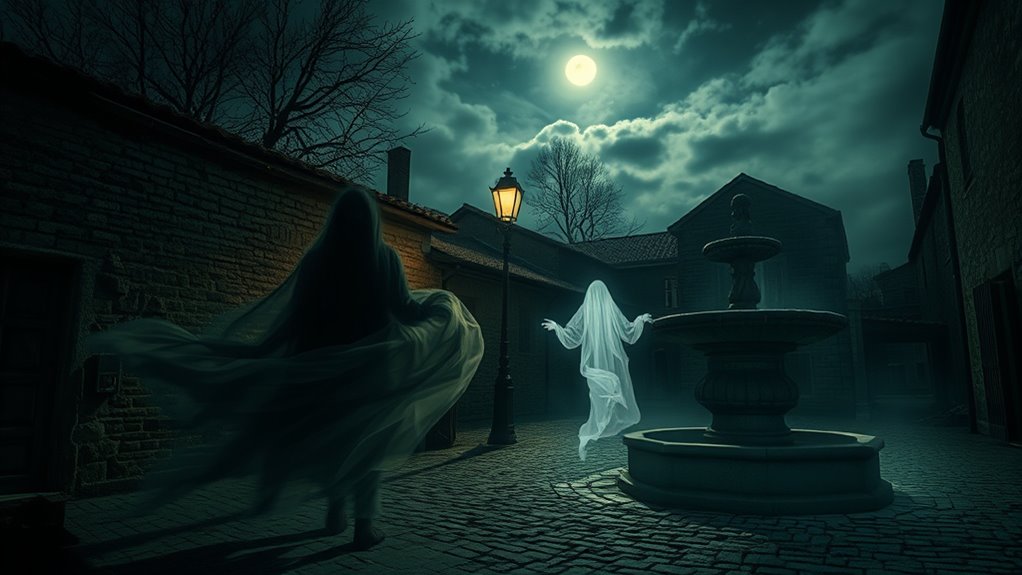
Different cultures interpret spirits in unique ways that shape their stories and beliefs. Folklore around the world features diverse spirits, ghosts, and poltergeists, reflecting local traditions and values. Exploring these variations helps you understand how perceptions of the supernatural differ across societies.
Cultural Interpretations of Spirits
Cultural beliefs shape how societies interpret spirits, often reflecting their history, values, and fears. In many cultures, spirits embody spiritual symbolism that guides rituals and practices. For example, some communities see spirits as ancestors watching over them, influencing daily ritual practices like offerings or ceremonies. Others view spirits as messengers or protectors, shaping their spiritual symbolism to reinforce social bonds. These interpretations influence how people respond to spirits, whether through prayer, sacrifice, or festivals. You might notice that in some cultures, spirits are integrated into religious rites, while in others, they’re seen as mischievous or dangerous entities. Understanding these cultural perspectives helps you appreciate the rich diversity in how humans connect with the unseen world, shaping their beliefs and behaviors accordingly.
Folklore Variations Worldwide
Across the world, folklore offers a fascinating array of stories and beliefs about spirits, revealing how societies interpret the unseen. In some cultures, spirits communicate through specific signs or rituals, emphasizing respectful contact with the supernatural. Haunted locations are often linked to tragic events or unfinished business, making them hotspots for spirit communication. Different regions have unique tales of ghostly entities, from restless souls seeking closure to mischievous poltergeists causing chaos. These variations reflect cultural values and fears, shaping how communities perceive and interact with spirits. Understanding these folklore differences deepens your appreciation for the diverse ways people interpret hauntings and spiritual activity around the world. It highlights that what’s considered a ghost in one culture might be a different entity elsewhere.
How They Are Perceived in Popular Media
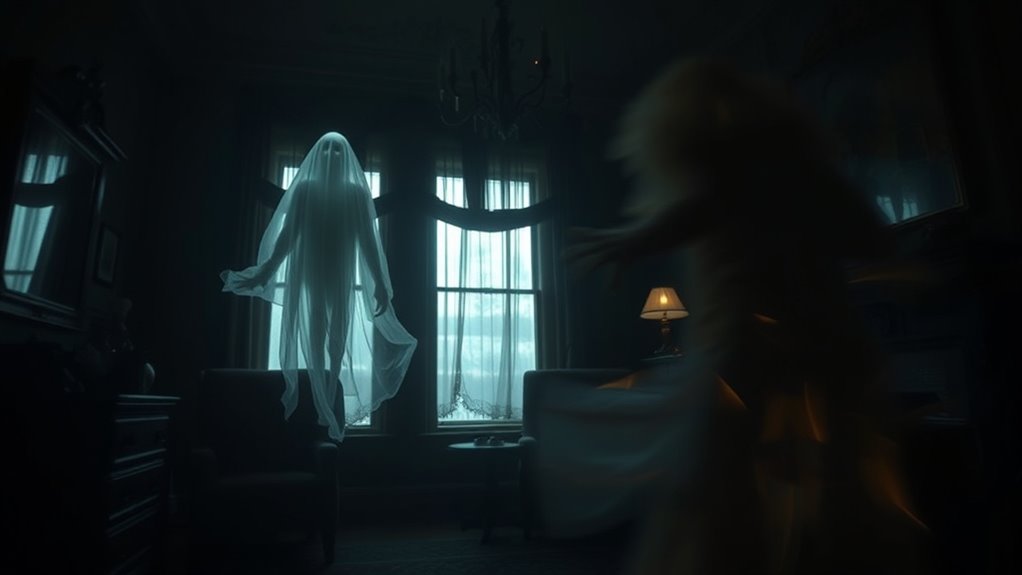
In movies and books, ghosts and poltergeists often take on dramatic and frightening roles that grab your attention. Their portrayals shape how you see these spirits, making them seem either mysterious or terrifying. This depiction influences how you feel about these supernatural entities and their presence in stories and popular culture.
Portrayal in Films
Films often shape how we perceive ghosts and poltergeists, frequently portraying them as dramatic, frightening entities that cause chaos and terror. This depiction influences how you view ghostly encounters and the nature of paranormal investigations. Movies often exaggerate supernatural activity, emphasizing loud noises, moving objects, and sudden appearances to heighten suspense. You might expect poltergeists to be more destructive, while ghosts are shown as lingering spirits seeking closure. These portrayals fuel public fascination and fear, making fictional scenes seem more real.
- They often highlight violent or mischievous behaviors, shaping expectations for real-life encounters
- Films tend to blur the lines between ghosts and poltergeists, creating confusion
- Popular media often uses special effects to intensify supernatural phenomena, impacting perceptions
Depiction in Literature
Literature has long shaped how we imagine ghosts and poltergeists, often portraying them with vivid descriptions that capture the imagination. In stories, spectral symbolism emphasizes their connection to unresolved emotions or history, making them powerful symbols of loss or guilt. Haunted portrayals in literature often depict ghosts as lingering spirits, while poltergeists are shown as disruptive, noisy entities. These depictions influence popular perception, blending fear with fascination. Below is a comparison of their literary portrayals:
| Aspect | Ghosts | Poltergeists |
|---|---|---|
| Spectral Symbolism | Reminders of unfinished business | Manifestations of emotional chaos |
| Portrayal Type | Silent, ethereal entities | Noisy, disruptive spirits |
| Common Themes | Loss, memory, mourning | Rage, disturbance, upheaval |
| Typical Actions | Appearing, whispering | Moving objects, loud sounds |
| Literary Tone | Melancholy, mysterious | Chaotic, unsettling |
Impact on Audience
Ghosts and poltergeists shape how audiences perceive supernatural phenomena by fueling both fear and fascination. They evoke strong emotional impacts that make stories memorable and compelling. Through popular media, these entities often symbolize unresolved spiritual significance, prompting viewers to reflect on life, death, and the unknown. You might find yourself questioning what’s real or feeling a connection to the unseen. This emotional engagement deepens your curiosity and heightens your senses during horror scenes or paranormal investigations.
- They reinforce cultural beliefs about spirits and the afterlife.
- Their portrayals can intensify fears about the supernatural’s influence.
- Their symbolic meanings evoke personal and collective spiritual reflection.
This impact influences how you interpret real-world phenomena and shapes your perceptions of the supernatural.
Methods of Identification and Differentiation
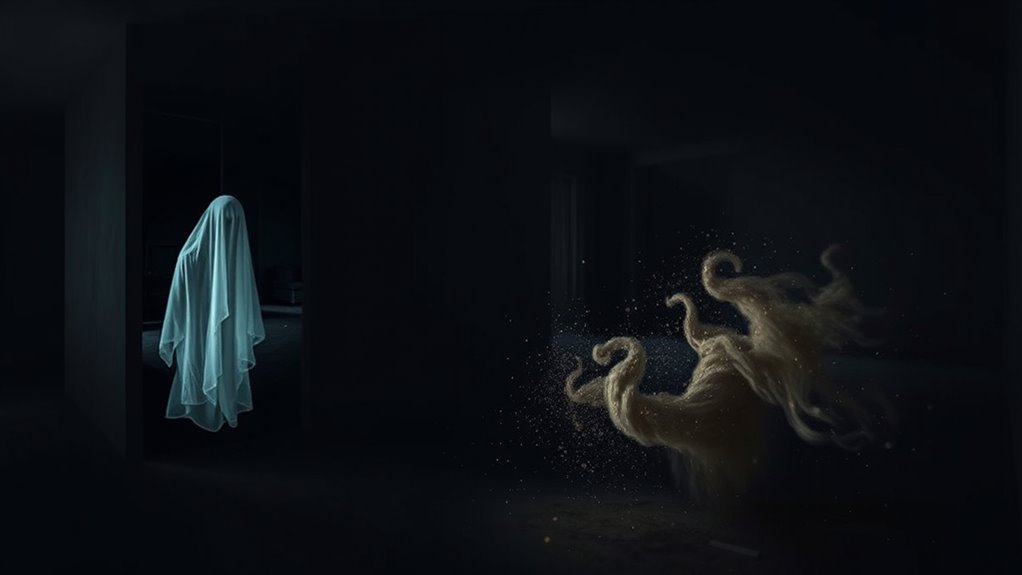
Identifying whether you’re dealing with a ghost or a poltergeist involves paying close attention to specific behavioral and physical signs. Ghosts often leave residual energy, which manifests as repetitive, unchanging phenomena like apparitions or sounds that seem stuck in time. In contrast, poltergeist activity tends to be more dynamic and disruptive, often involving objects moving spontaneously, loud noises, or physical disturbances. Poltergeists are typically linked to active energy, sometimes centered around a person, especially adolescents. To differentiate, observe the pattern: residual energy creates static, unchanging events, while poltergeists generate unpredictable, energetic disturbances. Recognizing these signs helps you determine whether you’re witnessing a lingering spirit or active, energetic poltergeist activity.
Frequently Asked Questions
Can Ghosts or Poltergeists Cause Physical Harm?
You might wonder if ghosts or poltergeists can cause physical harm. While some believe these entities are driven by strong paranormal energy and spiritual manifestations, most experts say actual harm is rare. However, intense activity or negative energy could lead to accidents or feelings of unease. Trust your instincts and seek help if you feel threatened, but remember, most paranormal phenomena are more about disturbance than danger.
Are Ghosts or Poltergeists More Common in Certain Locations?
You might notice that haunted locations often have geographic patterns, with certain areas more prone to ghost or poltergeist activity. Historically, old buildings, battlefields, and cemeteries are common spots for these phenomena. Ghosts tend to appear in places with strong emotional ties or tragic events, while poltergeists often manifest in homes with underlying stress or turmoil. So, your chance of encountering either depends largely on these haunted locations and their specific histories.
How Do Scientists Attempt to Study or Prove Their Existence?
Like explorers seeking hidden truths, scientists employ scientific measurement and paranormal investigation techniques to study spirits. You might see devices that detect EMF levels or record unexplained sounds, symbolizing the quest for understanding beyond the physical. While evidence remains elusive, these methods aim to differentiate genuine phenomena from illusions, pushing the boundaries of science. Your curiosity fuels the ongoing pursuit to prove or disprove the existence of spirits.
What Psychological Factors Influence Belief in Ghosts and Poltergeists?
You’re influenced by psychological factors like mass hysteria and cultural conditioning, which shape your belief in ghosts and poltergeists. When others share similar fears or stories, you might feel convinced, fueling collective hysteria. Cultural conditioning from movies, media, and traditions also plays a role, making you more receptive to supernatural explanations. These factors can lead you to interpret ambiguous events as paranormal, even when there’s no scientific evidence.
Are There Any Documented Cases of Genuine Poltergeist Activity?
Like shadows dancing in the dark, documented cases of genuine poltergeist activity are rare but intriguing. Historical reports often describe unexplained disturbances, yet many are later attributed to psychological or environmental factors. Cultural beliefs influence how these events are perceived and reported. While some claim authentic encounters, scientific validation remains elusive, leaving the question open-ended and fueling ongoing curiosity about whether true poltergeist activity ever truly occurs.
Conclusion
Ultimately, understanding the difference between a ghost and a poltergeist helps you see beyond the stories. Some experts believe poltergeists are just manifestations of human energy or stress, not spirits. This theory suggests that what you’re experiencing might be psychological rather than supernatural. So, next time you encounter strange activity, consider both possibilities—because sometimes, what seems paranormal might have a much more down-to-earth explanation. Trust your instincts, but keep an open mind.
